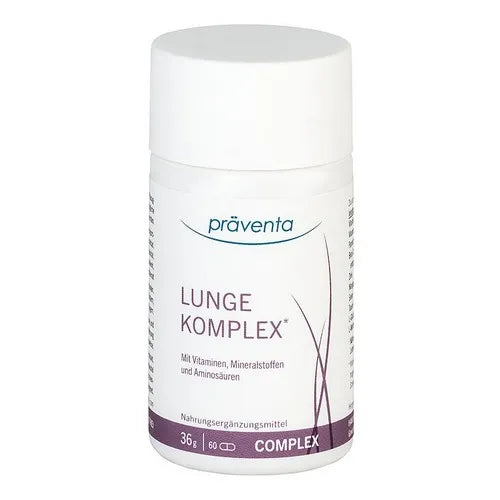Hawlik Gesundheitsprodukte GmbH
Lung Complex Capsules
Lung Complex Capsules
Couldn't load pickup availability
Lung Complex Capsules 60 pcs
*Delivery 3-9 working days more.
Lung Complex combines a high-quality blend of nutrients in one capsule that have antioxidant properties.
The lungs are known to be responsible for breathing in the body and are therefore a vital organ. They are responsible for the absorption and supply of oxygen in the body.
The lungs are known to be responsible for breathing in the body and are therefore a vital organ. They are responsible for the oxygen intake and supply in the body. The lungs absorb oxygen from the air we breathe and transport carbon dioxide away as an end product of the body's metabolism.
The health of the respiratory tract is influenced by diet, among other things. Both severe malnutrition and obesity put a strain on the respiratory tract. Smoking is also a risk factor for the respiratory tract, as it can increase oxidative stress. Antioxidants are compounds that can protect cells from oxidative stress. Not smoking (including passive smoking) and a healthy diet with plenty of fruit and vegetables (rich in antioxidants) are therefore also important for maintaining the health of the respiratory tract.
Lung Complex combines a high-quality mixture of nutrients in one capsule, which also have antioxidant properties.
Ingredients
These capsules contain:
Taurine, L-Glutathione (reduced), Hydroxypropylmethylcellulose (capsule shell), Calcium L-ascorbate, L-methionine, Zinc citrate, D-α-tocopheryl acetate, Beta-carotene, Manganese sulfate, Sodium selenite, Calcium D-pantothenate
Dietary supplement
ingredients
| nutrients and other substances | per daily dose (2 capsules) | % NRV* |
| vitamin C | 100 mg | 125 |
| vitamin E | 12 mg α-TE | 100 |
| pantothenic acid L-methionine | 4.6 mg | 77 |
| beta carotene | 2 mg | - |
| corresponds to vitamin A | 334 μg RE | 42 |
| zinc | 10 mg | 100 |
| manganese | 2 mg | 100 |
| selenium | 30 μg | 55 |
| taurine | 500 mg | - |
| L-glutathione | 200 mg | - |
| L-methionine | 100 mg | - |
*Nutrient reference value according to the Food Information Regulation
consumption recommendation
Take one capsule twice daily with plenty of liquid.
Note: The recommended daily intake must not be exceeded.
storage recommendation
Store out of reach of small children, in a cool, dry place protected from light.
Notice
A food supplement must not be taken as a substitute for a varied and balanced diet and a healthy lifestyle.
The plus of the ingredients
Vitamin E acts as an antioxidant to protect against oxidative stress. It is an essential, fat-soluble antioxidant that counteracts the oxidation of fats. Healthy polyunsaturated fatty acids are mainly susceptible to oxidation processes. If there is sufficient vitamin E in the body, radicals that attack unsaturated fatty acids can be intercepted.
The trace element zinc is particularly important in the human body because, as a co-factor of many enzymes, it is responsible for a normal immune system and cell division and has antioxidant properties. Among other things, it contributes to normal protein synthesis, fat and carbohydrate metabolism, the maintenance of normal bones, skin, hair, nails and vision.
Manganese protects cells from oxidative stress. It contributes to normal energy metabolism and is important for maintaining normal bones and normal connective tissue formation.
Selenium is essential to the functioning of the immune system and also has antioxidant properties.
L-methionine is one of the essential (vital) amino acids and cannot be produced by the human body itself. Therefore, sufficient intake through food is of considerable importance.
Glutathione is present in high concentrations in almost all cells of the body and is formed from three amino acids.
Zinc citrate has very good bioavailability and is better tolerated by the body than other zinc compounds. Therefore, even sensitive people can use zinc citrate without any problems.
Sodium selenite is quickly available in the body and is therefore absorbed faster than other selenium compounds.
Good to know
When you breathe in, air flows through the mouth and nose into the alveoli. There, the oxygen in the air is transferred to the red blood cells. From there, the oxygen-enriched arterial blood is transported to the tissues and cells. At the same time, the carbon dioxide from the red blood cells, which has been transported away from the tissues and cells, is released into the lungs so that it can be exhaled.
Share



